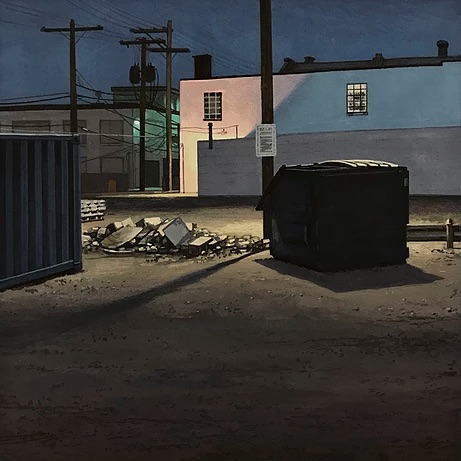Ohio nights

Construction Lot Nocturne, Gouache on paper, 8″ x 8″
There’s another week left in a show of small works by Christopher Burke, in Columbus, Ohio, at Brandt-Roberts. These carefully constructed urban nightscapes often have a dumpster or trash receptacle serving as fulcrum for everything else in the picture. In his choice of subjects, Burke has taken to heart Charles Hawthorne’s advice to go paint the train station. He paints the spot few others would stop to appreciate and makes it a source of pleasure. These paintings remind me of a variety of other work, in the best way possible–he’s assimilated his influences without being derivative. Matthew Cornell’s show not long ago at Arcadia, when it was still located in downtown Manhattan, depicted maybe a slightly earlier hour of twilight that bathed his assiduously realistic paintings of homes he’d inhabited throughout his life. As do Linden Frederick’s popular scenes of dusk. Burke favors the same crepuscular glow, the sky slipping into sleep mode, with artificial lamps already burning in back streets. Yet his images are astringent, abstracted and minimal, structured into grids of crisply delineated form. His palette is severely disciplined, pared down to a very basic range of hues, both in these and his usual oils of buildings in the daylight hours. Yet the emotion these gouaches evoke works like a faintly heard melody, their soft illumination pushing back against the quiet emptiness of deserted alleys and streets. Sometimes one of the skies in these paintings on paper suggests the light of the city itself shining up and then banking down off the clouds. It’s the light you see and love along with the bittersweet ache of solitude when walking home from a pub, with more than a bit of a buzz, at 2 a.m. (Those were the days.) It’s a world without human figures, everyone inside or else on the other side of town, a few windows shining with hints of routine domestic mysteries hidden behind those walls. What I love most about this series are his dumpsters and trash bins, the least picturesque subject one could pick at that hour, loved only by those who search for ways to survive another day by diving into them. The night gives Burke the ability to push his geometric bent even further toward abstraction in the way light falls and the shadows cut on the bias across a wall. There’s nothing here with a dimension larger than 16 inches and the smallest painting is 5″ x 7″, which is miniature to me, and yet the scale doesn’t diminish his ability to suggest detail and give his scenes the crisp definition reminiscent of Sheeler’s more representational paintings. But his mood is closer to Hopper, and even to the American Scene paintings from his fellow buckeye, Burchfield. Amazingly, he not only has this solo show of more than twenty paintings up now in Columbus, his two-person show in Chelsea at George Billis will open on Nov. 7.
Comments are currently closed.